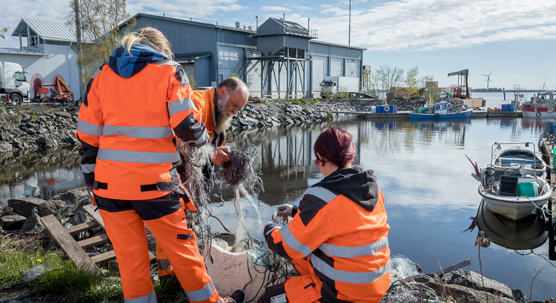Press release 2019-05-29 at 8:28
Ghost nets refer to nets and other gear lost by fishermen that fish by themselves in seas and bodies of water. They are harmful to animals and constitute a part of the plastic problem in the seas. The Finnish Environment Institute (SYKE) and the Finnish Fishermen’s Association (SAKL) have started to investigate the ghost net situation in the Bothnian Sea.

The project develops waste management and the collection of fishing gear. Unusable fishing gear was collected at Reposaari fishing harbour in the spring 2019. © Markku Saiha / Paapuuri Oy
Ghost nets are not a new phenomenon. Globally, a discussion on the topic arose in the 2000s due to the plastic problem in the seas, but the phenomenon itself originates from the mid-1900s. At that time, the natural fibres used to manufacture fishing gear began to be replaced with synthetic materials, such as nylon. The durability of the fishing gear improved, but this also created a problem with ghost nets.
Fishing gear made out of various plastics disintegrates extremely slowly in the sea. It has been estimated that ghost nets constitute one tenth of all plastic waste that ends up in the seas globally, which makes them the most significant type of underwater plastic waste.
Lost catches
Ghost nets do not only catch fish. In addition to fish, sea birds get tangled in fishing gear found in shallow waters and seals get caught in gear connected to wreckage. All these species caught by ghost nets have been found in the Baltic Sea, too. The catch of the ghost nets does not feed humans or animals; instead, it is simply lost.
Ghost nets keep on fishing for a long time, typically several months, but in the depths of the oceans of the world, they may go on fishing for years. In time, the nets become weighed down by the catch they accumulate and sink to the bottom. In addition, the nets become covered in slime, which reduces their ability to fish.
No assessment of the location, amount or effects of ghost nets has been made before in Finland. This year, SYKE and the Finnish Fishermen’s Association (SAKL) have started a project to find out the amount and location of ghost nets. The study is being carried out in the Bothnian Sea, where commercial fishing is active and vital.
“There is no information available about the location or amount of ghost nets in our waters, and we cannot reliably estimate how much harm they are causing. Currently, no organised efforts have been made to collect ghost nets, and people are not informed about the issue,” says Head of Unit Mika Raateoja from SYKE.

Fishing gear that is broken, against current regulations or otherwise unusable has accumulated in fishing harbours. © Markku Saiha / Paapuuri Oy
The goal is to develop methods for collecting ghost nets suited to the conditions in Finnish territorial waters. The project is implemented in cooperation with professional fishermen, who are also currently collecting rubbish and ghost nets from the sea. More accurate information about the situation in the Bothnian Sea will be available in late summer, when the collection of ghost nets with a fishing vessel begins.
Based on initial results, commercial fishing does not currently seem to be a significant source of ghost nets in Finland. “Here in Finland, net fishing in the open sea areas has ended in practice, and in that sense, professional fishing does not produce ghost nets. In contrast, there is plenty of unused fishing gear found on land. For example, fishing gear that is broken, against current regulations or otherwise unusable has accumulated in fishing harbours,” says Kim Jordas, the CEO of Finnish Fishermen’s Association (SAKL).
The goal is to recycle net material
Fishing gear mainly consists of various plastics and metals. As such, they are valuable material for recycling. The Kapyysi project develops waste management and the collection of fishing gear. Waste management should be planned carefully and recycling should be organised so that the costs do not exceed the benefits. “The waste management of fishing gear should be organised so that plastics could be recycled as material, but if this isn’t possible, they should at least be used as energy. We are creating an action plan for coastal municipalities on how to collect fishing gear for the needs of the circular economy,” Raateoja says.
There is no information available about how many ghost nets can be found in inland waters, nor about how much recreational fishing contributes to the amount of nets. For example, people with holiday cottages have plenty of old nets in storage, and they should also be recycled.
More information
• Head of Unit Mika Raateoja, Finnish Environment Institute (SYKE), tel. +358 295 251 536, email: firstname.lastname@ymparisto.fi
• Kim Jordas, CEO, Finnish Fishermen’s Association (SAKL), tel. +358 400 720 690, email: firstname.lastname@sakl.fi
• Communication Specialist Eija Järvinen, Finnish Environment Institute (SYKE), tel. +358 295 251 242, email: firstname.lastname@ymparisto.fi
Pictures for media use
http://www.sakl.fi/index.php/fi/kapyysi/onko-suomessa-haamuverkkoja
© Markku Saiha / Paapuuri Oy